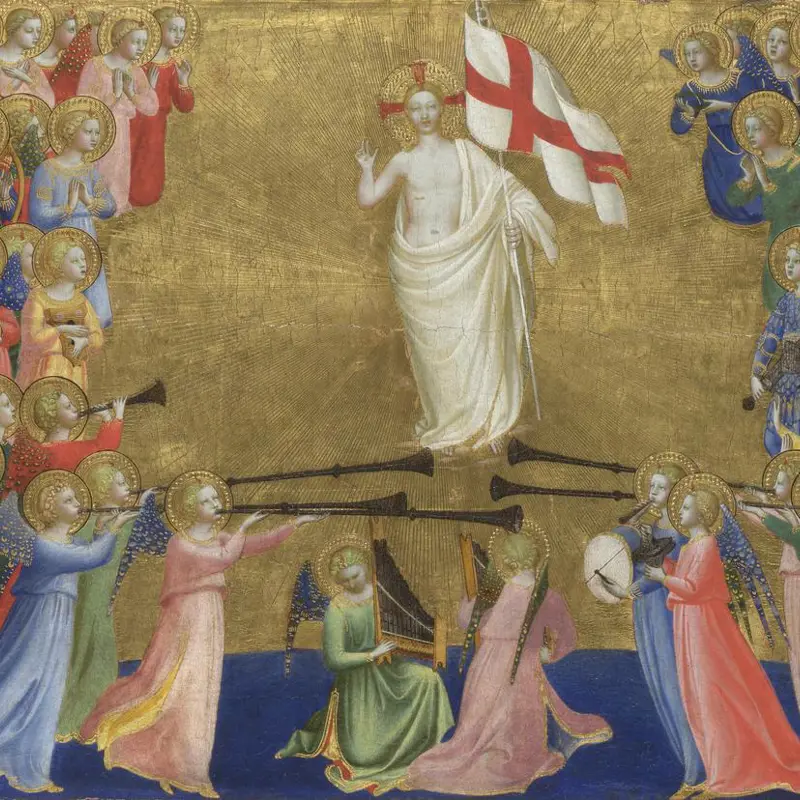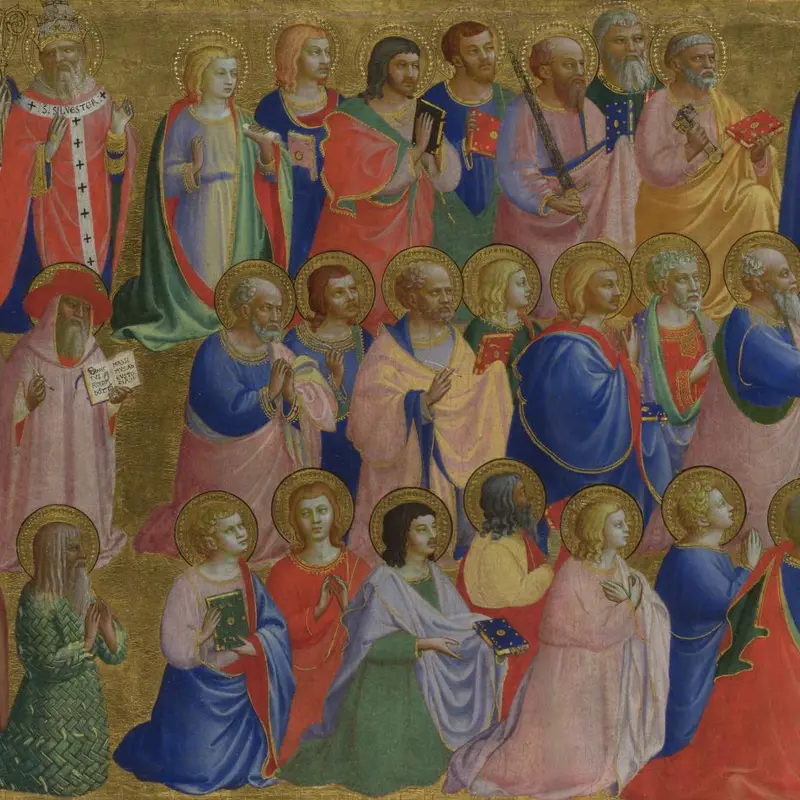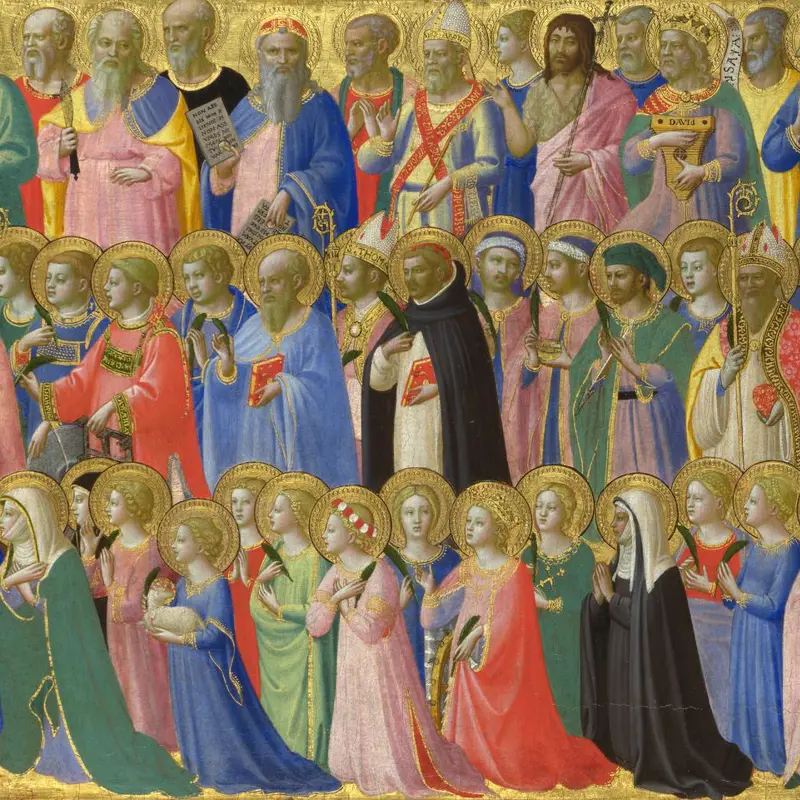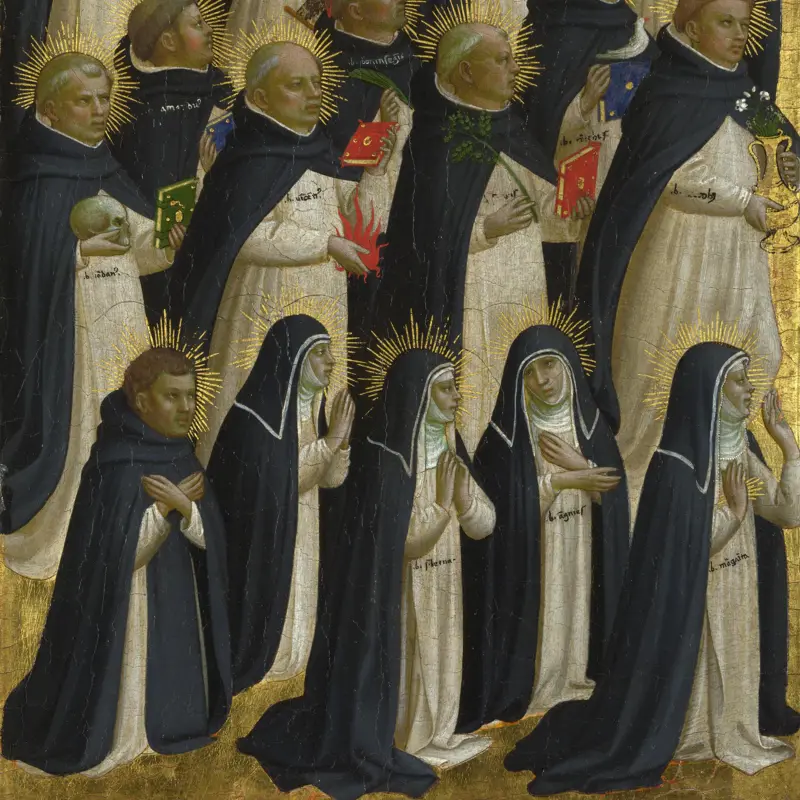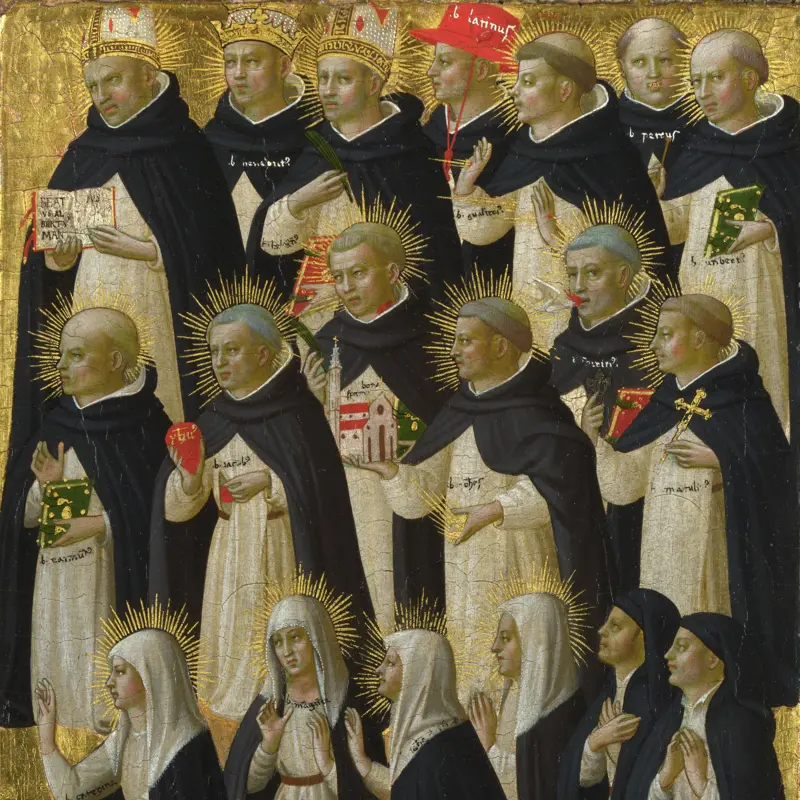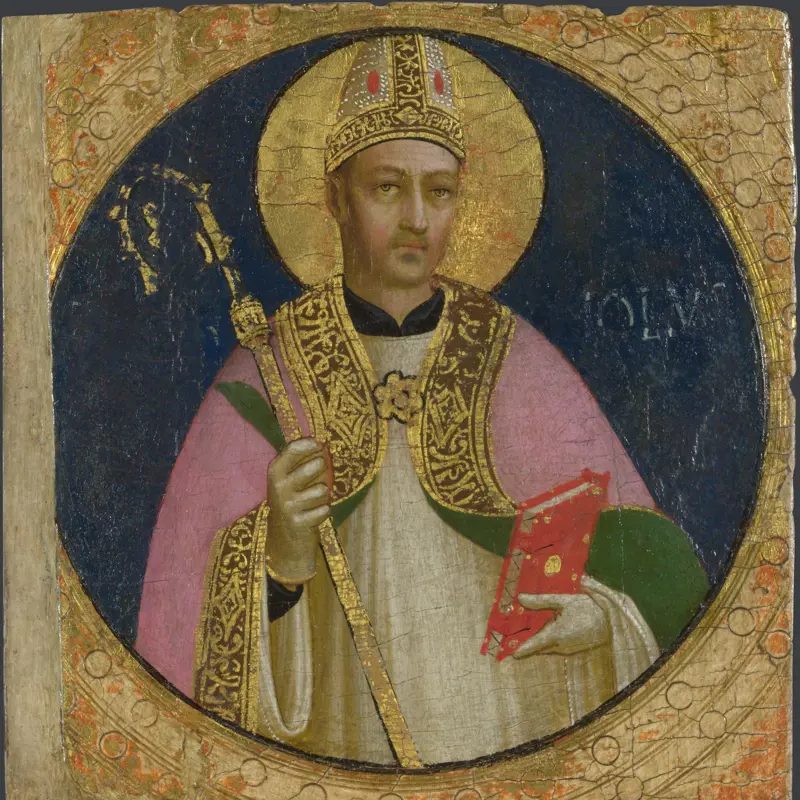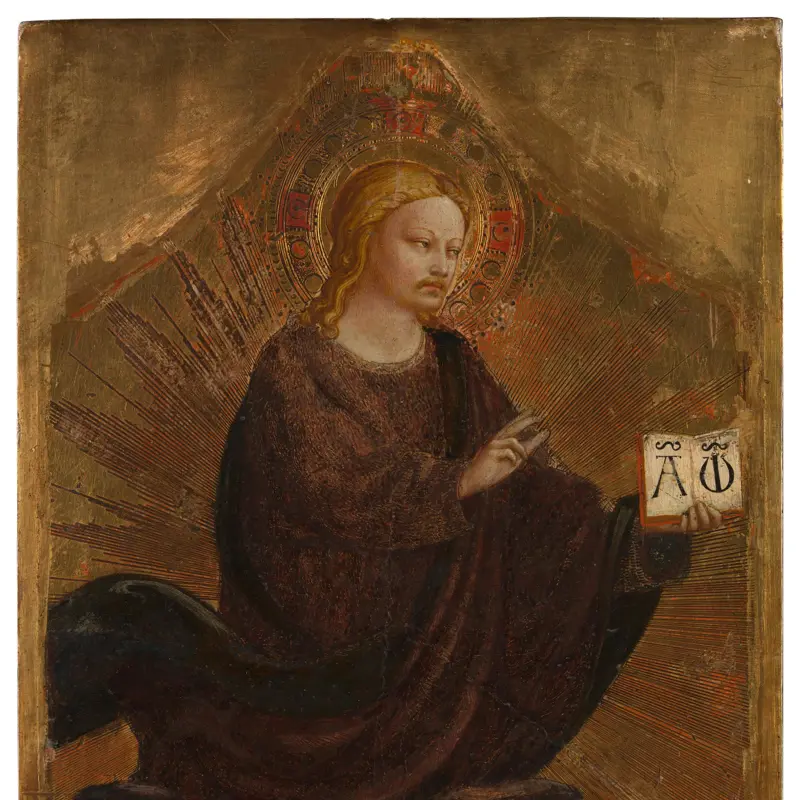Fra Angelico, 'Christ Glorified in the Court of Heaven', about 1423-4
About the work
Overview
Christ, hovering on wispy clouds, is surrounded by angels who sing, dance and play musical instruments. He is shown triumphant over death: his red and white flag was associated with his resurrection; the wound in his right hand, caused when he was crucified, is a reminder of his physical suffering. The artist has incised the gold leaf around him with radiating lines to show that he gives out a golden light.
This is the central panel of the predella (lowest part) of an altarpiece made by Fra Angelico, a painter and friar, for his own convent church of San Domenico in Fiesole, a town just outside Florence. The main part of the altarpiece is still in Fiesole but the predella is now in the National Gallery. It is unusual: it shows Christ in glory surrounded by saints and angels, rather than narrative scenes of the lives of the saints.
Key facts
Details
- Full title
- Christ Glorified in the Court of Heaven: Central Predella Panel
- Artist
- Fra Angelico
- Artist dates
- Active 1417, died 1455
- Part of the series
- Fiesole San Domenico Altarpiece
- Date made
- About 1423-4
- Medium and support
- Egg tempera on wood (probably poplar)
- Dimensions
- 31.7 × 73 cm
- Acquisition credit
- Bought, 1860
- Inventory number
- NG663.1
- Location
- Room 57
- Collection
- Main Collection
Provenance
Additional information
Text extracted from the ‘Provenance’ section of the catalogue entry in Dillian Gordon, ‘National Gallery Catalogues: The Fifteenth Century Italian Paintings’, vol. 1, London 2003; for further information, see the full catalogue entry.
Exhibition history
-
2015Visions of Paradise: Botticini's Palmieri AltarpieceThe National Gallery (London)4 November 2015 - 14 February 2016
-
2019Fra Angelico and the Rise of the Florentine RenaissanceMuseo Nacional del Prado28 May 2019 - 15 September 2019
Bibliography
-
1827C.F. von Rumohr, Italienische Forschungen, 3 vols, Berlin 1827
-
1878G. Vasari, Le vite de'più eccellenti pittori, scultori ed architettori: Con nuove annotazioni e commenti di Gaetano Milanesi, ed. G. Milanesi, 8 vols, Florence 1878
-
1900R.L. Douglas, Fra Angelico, London 1900
-
1903J.A. Crowe and G.B. Cavalcaselle, A History of Painting in Italy, Umbria, Florence and Siena, from the Second to the Sixteenth Century, ed. R.L. Douglas, 2nd edn, 6 vols, London 1903
-
1905M. Wingenroth, Angelico da Fiesole, Leipzig 1905
-
1911F. Schottmüller, Fra Angelico da Fiesole, Stuttgart 1911
-
1923R. van Marle, The Development of the Italian Schools of Painting, 19 vols, The Hague 1923
-
1933O.H. Giglioli, Catalogo delle cose d'arte e di antichità d'Italia, Rome 1933
-
1951Davies, Martin, National Gallery Catalogues: The Earlier Italian Schools, London 1951
-
1952J. Pope-Hennessy, Fra Angelico, London 1952
-
1958M. Salmi, Il Beato Angelico, Spoleto 1958
-
1961M. Davies, The Earlier Italian Schools, 2nd edn, London 1961
-
1976P.J. Cardile, Fra Angelico and His Workshop at San Domenicoin Fiesole (1420-1435): The Development of His Style and the Formation of His Workshop, Phd Thesis, Yale University 1976
-
1977U. Baldini, 'Contributi all'Angelico: Il Trittico di San Domenico di Fiesole e qualche attra aggiunta', in Scritti di storia dell'arte in onore di Ugo Procacci, Milan 1977, pp. 236-45
-
1980D.C. Ahl, 'Fra Angelico: A New Chronology for the 1420s', Zeitschrift für Kunstgeschichte, XLIII, 1980, pp. 360-81
-
1983M. Boskovits, 'La fase tarda del Beato Angelico: Una proposta di interpretazione', Arte Cristiana, 694, 1983, pp. 11-24
-
1986Davies, Martin, National Gallery Catalogues: The Earlier Italian Schools, revised edn, London 1986
-
1990F. Scalia, 'Contributo all'Angelico: Nuovi documenti per il ciborio di San Domenico di Fiesole', Critica d'arte, LV, 1990, pp. 34-40
-
1991J. Dunkerton et al., Giotto to Dürer: Early Renaissance Painting in the National Gallery, New Haven 1991
-
1993W. Hood, Fra Angelico at San Marco, New Haven 1993
-
1994L. Kanter et al., Painting and Illumination in Early Renaissance Florence 1300-1450 (exh. cat. Metropolitan Museum of Art, 17 November 1994 - 26 February 1995), New York 1994
-
1994M. Boskovits, 'Un Adorazione dei Magi e gli inizi dell'Angelico (1976)', in M. Boskovits, Immagini da meditare: Ricerche su dipinti di tema religioso nei secoli XII-XV, Milan 1994
-
1997C. Gardner von Teuffel, 'Fra Angelico's Bishop Saints from the High Altar of S. Domenico, Fiesole', The Burlington Magazine, CXXXIX/1132, 1997, pp. 463-5
-
2001
C. Baker and T. Henry, The National Gallery: Complete Illustrated Catalogue, London 2001
-
2003Gordon, Dillian, National Gallery Catalogues: The Fifteenth Century Italian Paintings, 1, London 2003
About this record
If you know more about this work or have spotted an error, please contact us. Please note that exhibition histories are listed from 2009 onwards. Bibliographies may not be complete; more comprehensive information is available in the National Gallery Library.
Images
About the series: Fiesole San Domenico Altarpiece
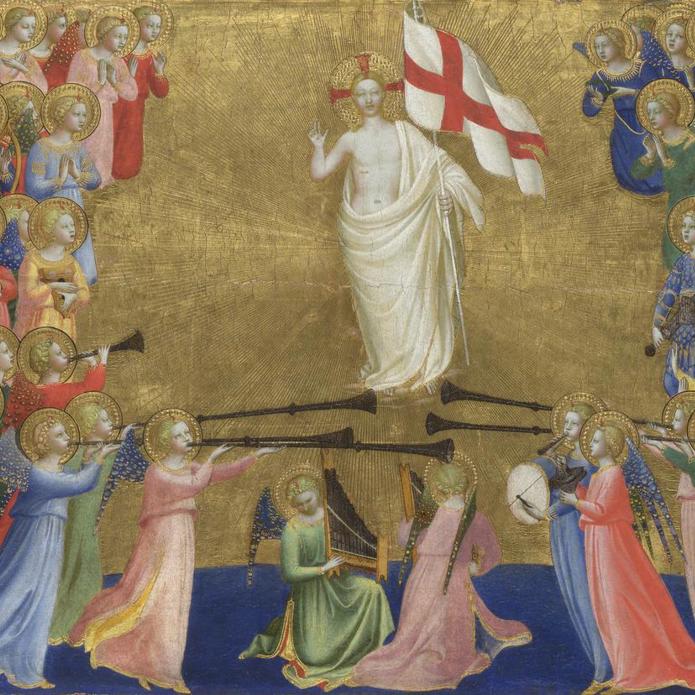
Overview
These panels come from the predella (lowest part) of the altarpiece made for the high altar of San Domenico, Fiesole. Fra Angelico was a Dominican friar (a member of the religious order founded by Saint Dominic) as well as a painter. The church was attached to his own convent – so although he made two other altarpieces for it, he was not paid for his work.
Predellas usually showed narrative scenes of the lives of the saints who were depicted in the main part of the altarpiece. This one is unusual: it shows Christ in glory in heaven, surrounded in the central scene by angels. This is framed by two panels showing rows of saints and Old Testament figures. These in turn are enclosed on either side by Dominican ‘Blessed’ figures who were holy and revered but not saints.
The mass of saints includes Dominicans and reflects their interest in the saints of their order and the place of the Dominicans in the broader church.

